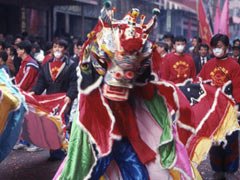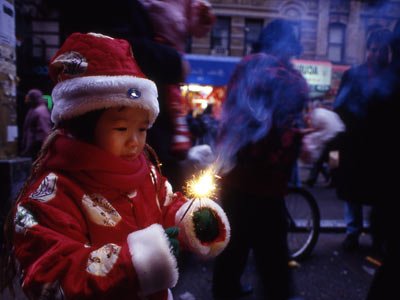-
Click here for VIDEOThe origins of the Chinese New Year celebrations were born out of fear and myth. Legend spoke of the wild beast Nien (which also is the word for "year") who appeared at the end of each year, attacking and killing villagers. To scare the beast away, loud noises and bright lights were used and thus the Chinese New Year celebrations were born.Today, the 15-day New Year festivities are celebrated with a week of vacation in metropolitan areas of China. Much like the Western New Year (January 1st), the biggest celebration is on the eve of the holiday. At the turn of the new year, fireworks cover the city.Aside from New Year's Eve, there are other important days of the 15-day New Year Festival, including:JIE CAI CENG - Welcoming the Gods of Wealth and ProsperityOn the 5th day of New Year's, it is believed that the gods of prosperity come down from the heavens. Businesses will often participate in setting off firecrackers as they believe it will bring them prosperity and good fortune for their business.YUAN XIAO JIE - Festival of LanternsThe 15th day of the New Year is known as The Festival of Lanterns and marks the end of the Chinese New Year celebrations. All types of lanterns are lit throughout the streets and often poems and riddles are often written for entertainment. There are also paper lanterns on wheels created in the form of either a rabbit or the animal of the year (Pig for 2007). The rabbit lantern stems from a Chinese myth or fairytale about a female goddess named "Chang E" who jumped onto the moon. So she wouldn't travel alone, she brough a rabbit with her to keep her company. It is said that if your heart is pure enough, you can see the goddess Chang E and her rabbit on the moon on this day.
 SYMBOLSRed envelopesCalled "hong bao" in Mandarin, the red envelopes filled with money are typically only given to children or unmarried adults with no job. If you're single and working and making money, you still have to give the younger ones the hong bao money. The color red denotes good luck/fortune and happiness/abundance in the Chinese Culture and is often worn or used for decoration in other celebrations.DragonThe Dragon is present in many Chinese cultural celebrations as the Chinese people often think of themselves as descendants of the mythical creature. On the fifth day of the New Year when many people have to start going back to work, they will also have the Dancing Dragons perform in the front of the office building. On the 15th day of the New Year (Yuan Xiao Jie), they will also have a lot of dancing dragon performances. The dragon represents prosperity, good luck and good fortune.
SYMBOLSRed envelopesCalled "hong bao" in Mandarin, the red envelopes filled with money are typically only given to children or unmarried adults with no job. If you're single and working and making money, you still have to give the younger ones the hong bao money. The color red denotes good luck/fortune and happiness/abundance in the Chinese Culture and is often worn or used for decoration in other celebrations.DragonThe Dragon is present in many Chinese cultural celebrations as the Chinese people often think of themselves as descendants of the mythical creature. On the fifth day of the New Year when many people have to start going back to work, they will also have the Dancing Dragons perform in the front of the office building. On the 15th day of the New Year (Yuan Xiao Jie), they will also have a lot of dancing dragon performances. The dragon represents prosperity, good luck and good fortune.
Last Modified on November 5, 2007



